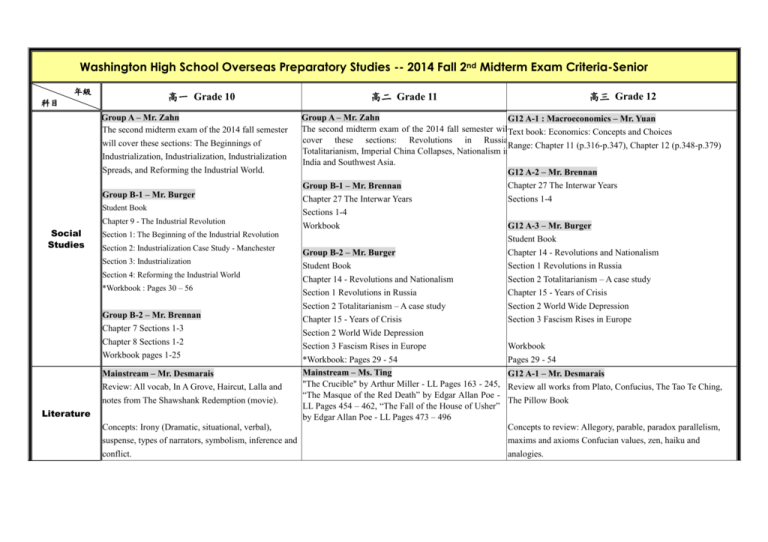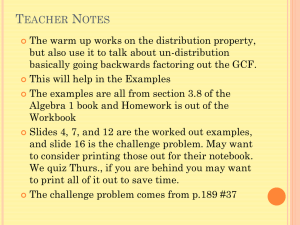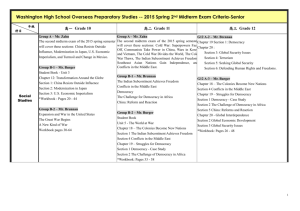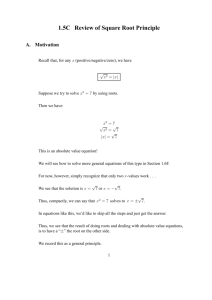Washington High School Overseas Preparatory Studies
advertisement

Washington High School Overseas Preparatory Studies -- 2014 Fall 2nd Midterm Exam Criteria-Senior 年級 高一 Grade 10 科目 Group A – Mr. Zahn The second midterm exam of the 2014 fall semester will cover these sections: The Beginnings of Industrialization, Industrialization, Industrialization Spreads, and Reforming the Industrial World. Group B-1 – Mr. Burger Student Book Chapter 9 - The Industrial Revolution Social Studies Section 1: The Beginning of the Industrial Revolution Section 2: Industrialization Case Study - Manchester Section 3: Industrialization Section 4: Reforming the Industrial World *Workbook : Pages 30 – 56 Group B-2 – Mr. Brennan Chapter 7 Sections 1-3 Chapter 8 Sections 1-2 Workbook pages 1-25 Mainstream – Mr. Desmarais Review: All vocab, In A Grove, Haircut, Lalla and notes from The Shawshank Redemption (movie). Literature Concepts: Irony (Dramatic, situational, verbal), suspense, types of narrators, symbolism, inference and conflict. 高三 Grade 12 高二 Grade 11 Group A – Mr. Zahn G12 A-1 : Macroeconomics – Mr. Yuan The second midterm exam of the 2014 fall semester willText book: Economics: Concepts and Choices cover these sections: Revolutions in Russia, Range: Chapter 11 (p.316-p.347), Chapter 12 (p.348-p.379) Totalitarianism, Imperial China Collapses, Nationalism in India and Southwest Asia. G12 A-2 – Mr. Brennan Chapter 27 The Interwar Years Group B-1 – Mr. Brennan Chapter 27 The Interwar Years Sections 1-4 Sections 1-4 Workbook G12 A-3 – Mr. Burger Student Book Chapter 14 - Revolutions and Nationalism Group B-2 – Mr. Burger Student Book Section 1 Revolutions in Russia Chapter 14 - Revolutions and Nationalism Section 1 Revolutions in Russia Section 2 Totalitarianism – A case study Chapter 15 - Years of Crisis Section 2 World Wide Depression Section 3 Fascism Rises in Europe *Workbook: Pages 29 - 54 Mainstream – Ms. Ting "The Crucible" by Arthur Miller - LL Pages 163 - 245, “The Masque of the Red Death” by Edgar Allan Poe LL Pages 454 – 462, “The Fall of the House of Usher” by Edgar Allan Poe - LL Pages 473 – 496 Section 2 Totalitarianism – A case study Chapter 15 - Years of Crisis Section 2 World Wide Depression Section 3 Fascism Rises in Europe Workbook Pages 29 - 54 G12 A-1 – Mr. Desmarais Review all works from Plato, Confucius, The Tao Te Ching, The Pillow Book Concepts to review: Allegory, parable, paradox parallelism, maxims and axioms Confucian values, zen, haiku and analogies. 10B-1 – Mr. Boyd Literature covered are and will be ‘Marriage is a Private Affair’ – analyzed how the author used characters to represent his/her critique on society and culture. Also looked at how conflict was used to express opinions of society. 11B-1 – Mr. Gill Jackson “The Possibility of Evil” and Hinton “The Outsiders” -the contents of these stories -the vocabulary on the handouts on these stories -the vocabulary highlighted in the book -the literary terms explained in the book in the sections on these stories -the aspects of the stories discussed in the homework questions and in class fill in the blank vocabulary (30%), short answer vocabulary (10%), short answer stories (30%), longer writing stories (30%) G12 A-2 – Mr. Gill - McPhee “Oranges”, Aviv “A Valuable Reputation” -the contents of the book and article -the vocabulary on the handouts on this book and article -the aspects of the articles discussed in the homework questions and in class fill in the blank vocabulary (30%), short answer vocabulary (10%), short answer articles (20%), longer writing articles (40%) 10B-2 – Ms. Chen The ransom of red chief The king of Mazy May - Vocabulary -Literary Analysis -Plot - Short questions 11B-2 – Ms. Chuang G12 A-3 – Mr. Dumont · comprehend the meaning and the usage of these Vocabulary – from Sundiata & The Lottery words: INFATUATED / DEGRADED / Readings – Sundiata & The Lottery TRANSLUCENT / ASSEMBLE / STERN / HESITATE Literary devices – Tone, Symbolism, foreshadowing, irony, / INDULGENT / DELICATE / INHERIT / BANISH / analogy MENTOR / TACT / CATALYST / POTENTIAL / Cultural Beliefs & Values passed on through literature. DYNAMIC / SEEK / UNDERGO / EXECUTE / REGUGEE / TORTURE / PERISH / RINGLET / QUENCH · understand the main ideas of The Possibility of Evil and The Teacher Who Changed My Life · comprehend and identify the literary terms: - characterization in nonfiction - character motivation sound devices: end rhyme, alliteration, onomatopoeia, couplet · demonstrate the understanding of the reading texts: - author’s purpose - make inferences - reading poetry G10 A Grammar –Ms. Ting G11A: Writing—Mr. Desmarais Chapter 13 Adjective Clauses - Understanding and UsingHand in persuasive essay English Grammar 4th edition, Pgs. 270 - 300 12A-2 Writing – Mr. Armstrong Students must hand in a complete assignment, including all backup work, planning, drafting and typed copy. G10 A Writing –Ms. Ting No Exam - Turn in Persuasive Problem/Solution EssayFinal Draft 10B-1 Grammar – Ms. Chen Grammar & Writing Unit 6&7 -Nouns and pronouns -modal auxiliaries -Review the quiz paper -Exercise in the textbook -review TOEFL VOC 10B-1Writing – Mr. Dumount Vocabulary of Persuasion- Handout Identifying and explaining Topics & Issues Creating Thesis statements Developing Persuasive Paragraphs Content & Structure of i) a thesis statement ii) a persuasive paragraph Students will apply the persuasive writing skills learned this term to new content provided on the exam 12 A-1 Writing – Mr. Desmarais Hand in major expository essay. 12A-3 Writing – Mr. Gill Writing book, units 1,2 Students will be given various questions relating to identifying classification, narrative, comparison, and the skills/concepts/devices taught during the term. argument essays They will also be given an article to read which introduction paragraphs, hooks, and thesis statements they must use as the basis of a persuasive essay. body paragraphs, transitions, and concluding paragraphs The essay they produce must me structured as the narrative essay taught in class. grammar: connectors and time-relationship words, adjective clauses 11B-1 Writing – Mr. Armstrong short answer (30%), writing exercises (70%) 10B-2 Grammar – Mr. Lu 11B-2 Writing – Ms. Chuang Ch4 (using the present progressive), Ch5( talking about the present) Test includes Fill in the blanks, complete the conversations, making questions, error analysis and essay writing The simple present tense V.S the present progressive · · · · See, look at, watch, hear, and listen to Need and Want + A noun or infinitive Prepositions of place/time 10B-2 Writing – Mr. Boyd Creating second, third and fourth body paragraphs with appropriate structure (topic sentence or introductory sentence, details of topic sentence V+S agreement, and flow in connecting sentences within a paragraph. Recognizing and creating good supporting sentences, editing paragraphs for proper punctuation. Creative piece of work using inference to finish a story (used to assess fluidity and idea generation from brainstorming). Structure of a concluding sentence in relation to topic sentence. Seven steps of wiring process Describing with the five senses Using prepositions Write descriptive paragraph and essay Group A – Mr. Willemse Group A – Mr. Willemse Group A – Mr. Willemse Old Textbook: Equations and Inequalities 1.1-1.7 Linear Equations and Functions 2.1-2.8 Linear Equations in three variables3.5 New Textbook: 2.1 Linear Functions 1.1-1.4 Trigonometric Functions 5.1-5.6 Inverse Trigonometric Functions and Identities 6.1-6.3 Trigonometric Formulas 6.4-6.5 Solving Trigonometric Functions 6.7-6.8 Law of Sines 7.2 Limits and Continuity 1.1-1.5, 3.5 Differentiation Rules 2.1 – 2.6 Exponential and Logarithmic Derivatives 5.1-5.5 Derivatives of Inverse Functions 5.3, 5.6 Extrema on an Interval 3.1 Rolle’s Theorem and Mean Value Theorem 3.2 Group B-1 – Mr. Steele Trigonometric Functions 5.1-5.6 Group B-1 – Mr. Steele Chapter: 2.7, 2.8, and 3.1 Group B-3 – Mr. Rocheleau 2.8 Absolute Value Functions/Transformations of Functions 3.5 Graphing Linear Equations in Three Variables 3.6 Solving Linear Systems in Three Variables 5.1 Graphing Quadratic Functions 5.2 Solving Quadratic Equations by Factoring Group B-3 – Ms. Chen Coordinate Plane Linear Function Absolute Value Inequality Solving Equations of degree n (including Complex roots) Rational Expressions and Equations Quadratic Functions Math 2.1-2.4 Group 10B-1- Mr. Steele 5.1 Graphing Quadratic Functions 5.2 Solving Quadratic Equations by Factoring 5.3 Solving Quadratic Equations by Finding Square Roots 5.4 Complex Numbers 5.5 Completing the Square 5.3 Solving Quadratic Equations by Finding Square Division of Polynomial Group 10B-3 – Mr. Rocheleau Roots 2.8 Absolute Value Functions/Transformations of Functions 5.4 Complex Numbers 3.5 Graphing Linear Equations in Three Variables 5.5 Completing the Square 3.6 Solving Linear Systems in Three Variables *Exam Questions 5.1 Graphing Quadratic Functions Multiple Choice: 30% 5.2 Solving Quadratic Equations by Factoring Short Answers/Comprehension: 40% 5.3 Solving Quadratic Equations by Finding Square Roots Critical Thinking: 30% 5.4 Complex Numbers 5.5 Completing the Square *Exam Questions Multiple Choice: 30% Short Answers/Comprehension: 40% Critical Thinking: 30% Science G10 Biology-- Mr. Rocheleau G11 Biology – Mr. Rocheleau Chapters 23-24, Textbooks, Workbooks and Quizzes 22.1 Introduction to Plants 22.2 Bryophytes 10B Physics – Mr. Backus 22.3 Seedless Vascular Plants Chapters 6-8, Textbook, Workbook and Quizzes 22.4 Seed Plants 22.5 Angiosperms – Flowering Plants 10B Chemistry -_ Mr. C. Willemse 23.1 Specialized Tissues in Plants Chapters 3-4, Textbook, Workbook, Quizzes 23.2 Roots 23.3 Stems 23.4 Leaves 23.5 Transport in Plants 24.1 Reproduction with Cones and Flowers 24.2 Seed Development and Germination 24.3 Plant Propagation and Agriculture 25.1 Hormones and Plant Growth 25.2 Plant Responses 25.3 Plant Adaptations *Exam Questions Multiple Choice: 30% Short Answers/Comprehension: 40% Critical Thinking: 30% 11B Chemistry – Mr. C. Willemse Chapters 3-4, Textbook, Workbook, Quizzes 11B Physics – Mr. Backus Chapters 6-8, Textbook, Workbook and Quizzes G12 AP Bio. & MOOC – Mr. C. Willemse Refer to online material 12B Chemistry – Mr. C. Willemse Chapter 13-15, Textbook, Workbook, Quizzes 12B Physics – Mr. Backus Chapters 15-17, Textbook, Workbook and Quizzes Macroeconomics: Text book: Economics: Concepts and Choices Range: Chapter 3 (p.68-p.95) and Chapter 10 (p.286-p.315) G12 Introduction to management Text book: Management Basic Range: p.29-p.56 G12 Chemistry II Ions in Aqueous Solutions and Colligative Properties 13.1 Compounds in Aqueous Solutions 13.2 Colligative Properties of Solutions Acids and Bases 14.1 Properties of Acids and Bases 14.2 Acid-Base Theories 14.3 Acid-Base Reactions Acid-Base Titration and pH 15.1 Aqueous Solutions and the Concept of pH 15.2 Determining pH and Titrations *Exam Questions: Multiple Choice: 30%, Short Answers/Comprehension: 40%, Critical Thinking: 30% Psychology G12 Student Book Chapter10: – Infancy and Childhood Section 2 – Physical Development Section 3 – Social Development Section 4 – Cognitive Development Chapter 11 – Adolescence Section 1 – Physical Development *Workbook: Pages 23 - 43






